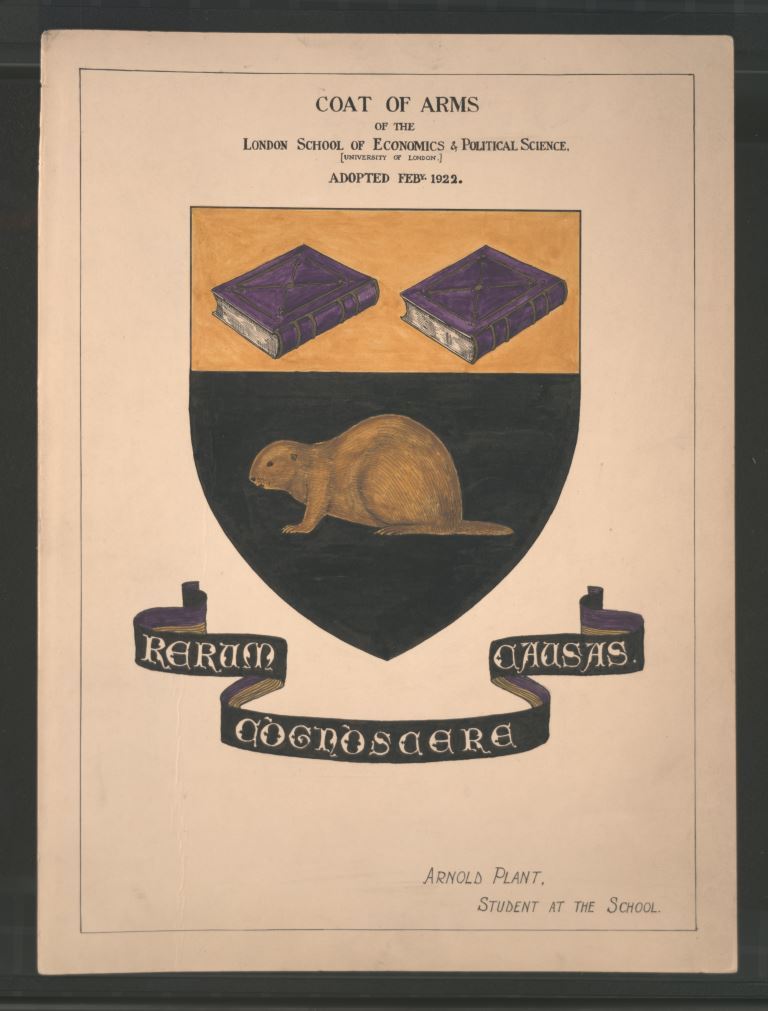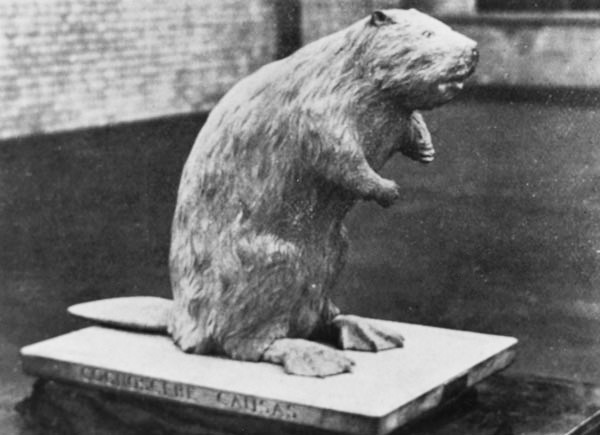LSE’s coat of arms, motto “rerum cognoscere causas” and Beaver mascot were adopted in 1922 under Director William Beveridge and School Secretary Jessy Mair. LSE Archivist Sue Donnelly shares the story of how they came about and who designed them. She names the winner of the School’s motto competition – and provides some of the unsuccessful entries.
Entering the Old Building from Houghton Street, visitors walk beneath the LSE coat of arms selected during the Directorship of William Beveridge. Beveridge was determined that LSE take its rightful place among Britain’s universities, an ambition that led to the purchase of the first LSE sports ground and the adoption of the LSE crest and motto as well as more academic achievements.
In 1919 black, purple and gold were adopted as the School colours and towards the end of 1920 the question of an emblem and motto was raised. Initially Beveridge couldn’t decide whether the School needed a simple emblem or a full blown coat of arms. He raised the issue with LSE co-founder Sidney Webb in April 1921 but Webb simply replied, “This is beyond me … I am afraid I am useless at all this”.

LSE/Unregistered/25/6/1. LSE
In March 1921 the School Secretary Jessy Mair took advice on the process and possible design from Emery Walker (1851-1933) an engraver, typographer and photographer with connections to the School through both Sidney Webb and G Bernard Shaw. Walker advised that the £76 10s required to enroll a coat of arms might be too expensive for a small institution like LSE but in April he designed a monogram composed of the initial letters of the London School of Economics and Political Science. He found designing an emblem challenging:
Thoughts of Economics somehow do not seem very provocative of ideas for objects suitable for badges.
In 1921 the School established a committee to consider the issue. Chaired by Professor Gutteridge, the Sir Ernest Cassel Professor of Industrial and Commercial Law, the committee included LSE co-founder, Graham Wallas, the School Secretary, Jessy Mair, and eight student representatives. At the first meeting on 24 May the students opposed the use of the monogram and supported the adoption of a coat of arms despite the cost. Indeed in June the President of the Students’ Union agreed to contribute up to £15 towards the costs of enrolling the coat of arms.
The committee decided to adopt a coat of arms using “the figure of some animal which would be emblematic of the work of the School. It was agreed “that a beaver would be very suitable”. Unfortunately the committee did not explain why a beaver was so appropriate. In his 1922 Oration Day speech Beveridge said it was:
Needless to point out the appropriateness to the School of Economics of an animal of such social habits, so constructive and gifted, with such foresight as is the beaver.
However he mischievously pointed out that the beaver’s character was disputed:
The beaver is also reputed to be industrious, though one writer at least has been found to assert that this reputation is undeserved; ‘that for five long months in winter the beaver does nothing but sleep and eat and keep warm’ that ‘summer-time for him is just one long holiday when the beavers are as jolly as grigs with never a thought of work from morning to night,’ and that in fact, he never works at all except in September and October when his dam must be built and when the Final Examination of the University are held.

The design was produced by Arnold Plant – President of the Student’s Union 1922/1923 and later Professor of Commerce. Plant was an excellent draughtsman who left a record of his teachers in the margins of his lecture notes. Despite his draughtsman’s skills it took 11 attempts to come up with an acceptable design. In July 1922 an application was made to the College of Arms. Beveridge remained unhappy about the high cost but wanted a coat of arms that was “beyond criticism”. The College of Arms enrolled the design as:
Sable a Beaver passant Or on a chief of the Second two closed Books Purpure clasped leaved and decorated gold.
Alongside the coat of arms the School required a motto. The School Secretary had offered a prize of one guinea to the student who made the best suggestion. In fact the challenge was taken up by members of staff rather than students. Twenty four suggestions were received. Abraham Wolf, Professor of Philosophy, included the surely tongue in cheek “Burrow and Build” and “Beaveracious”. Sidney Webb came up with “By Measurement and Publicity” and “Social Service” – neither guaranteed to inspire.
Finally Edwin Cannan, Professor of Political Economy suggested “Rerum cognoscere causas” – to know the causes of things, taken from Book 2 of Virgil’s Georgics. The full quotation is “Felix qui potuit rerum cognoscere causas”. It has been a popular choice although LSE is not the only university to use this motto. Sheffield University took it from a predecessor institution, Firth College, established in 1879 as a science college. It is also the motto of the German newspaper Der Tagesspiegel.
The episode was rounded off in 1925 when the staff gave the Students’ Union a wooden beaver carved by Alfred Southwick, a sculptor based in Camden Studios, who worked on the cathedrals at Liverpool and Carlisle. The only possible name for the beaver was Felix.

Beveridge was pleased with the discussion and debate the coat of arms and motto had encouraged:
The School of Economics, between the wars gave itself to plenty of cheerful nonsense with brains behind it.






What an illuminating history. Thank you. Felix sure did earn its digs.
Very interesting. Both my parents went to LSE and would quote the full Latin tag to me. My mother had her studies funded by the government as she had taken a part in the First World War as a VAD. Not many people seem to know about this influence of the 1st W W on the emancipation of women. (She also had Clement Attlee as a tutor). My father, I think, did his degree as an evening student while holding down a day job.
With all due respect to beavers…busy and otherwise…the version of ‘Felix’ on the coffee mug looks more like a pissed-off otter. The tail is too thin for a beaver’s paddle, and the facial expression suggests that the critter just failed Macroeconomics 101 :-).